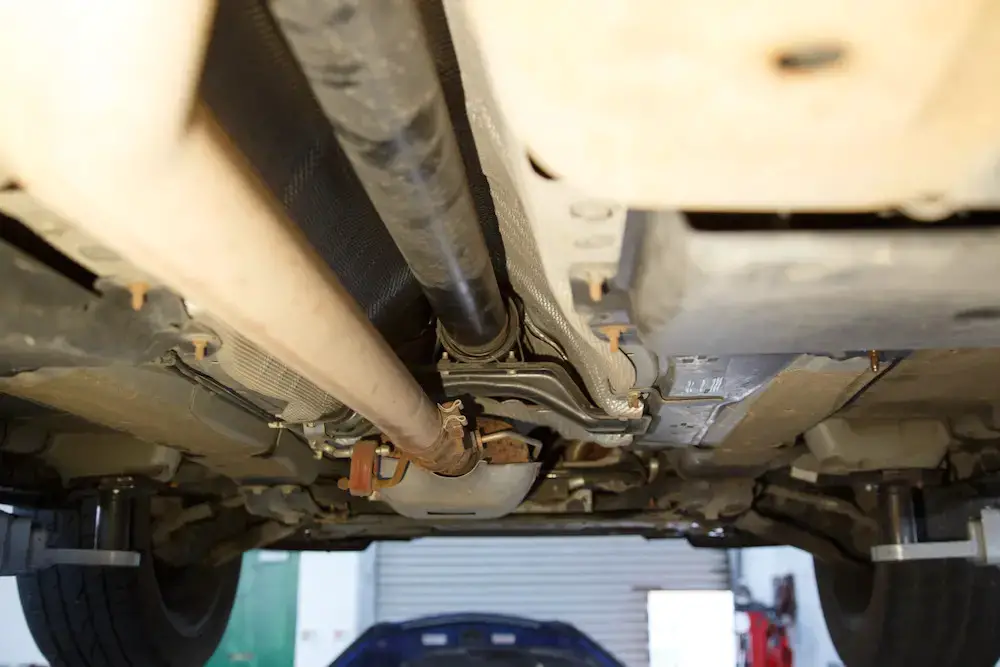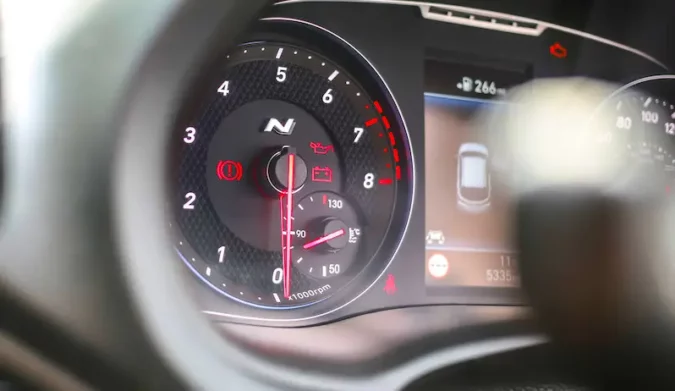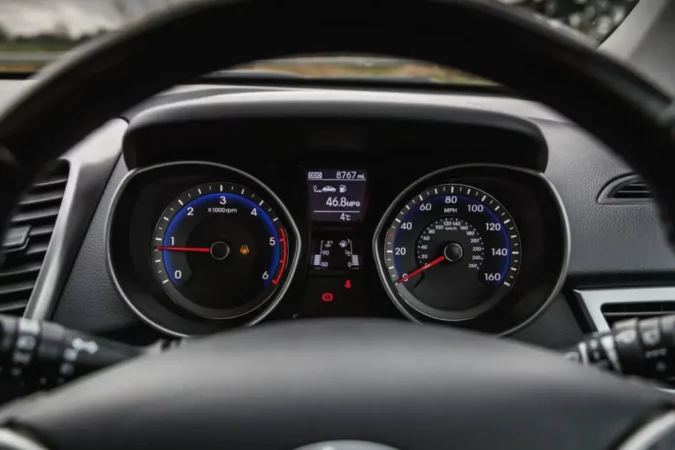Have you noticed the check engine light on the cluster and diagnosed a P0158 code? Well, if that is the case, then you are in the right place because, in this article, there will be a lot to cover on this topic.
- Car Diagnostics
- Bank 1 vs Bank 2
- O2 Sensor
- Bank 2 Sensor 2
- The Problem
- Causes
- Symptoms
- Diagnosing
- Conclusion
- FAQs
Doing your research on a car problem is always a good idea. Especially when it is not something crazy complex like a sensor or a simple fuse to be changed. Knowing how to fix these simple things will save you hundreds or even thousands of dollars throughout your ownership period.
So, you get the idea of why putting up your sleeves and start learning more about how to fix car problems is the way to go. And this is why we are here, to share our knowledge with you and help you out. First, we are going to learn more about car diagnostics in general.
Then we are going to learn the difference between bank 1 and what is an O2 sensor. Also, where is bank 2 sensor 2 located? Once we clear all that, we will cover the definition of the P0158 code, as well as the causes, symptoms, and how to diagnose it. So, if you want to learn more, follow along.
Car Diagnostics
Now before we dive into more complex topics and elaborate on the code P0158. Before we do so, let’s cover some of the basics first. There are a lot of people with similar issues who want to have the grasp of knowledge needed in order for them to be able to diagnose problems.
When it comes to solving problems with your car, you should know that modern cars are nothing alike old-school classic cars.
All cars after 1996 have shifted to computer diagnostics and all of them are OBD2 standardized. So, what does this mean?
This means that in order for you to diagnose problems with your car, you need to have an OBD2 scanner tool to access the computer of the car.
You have to locate the OBD2 port for your car first and then plug in the OBD2 scanner to scan for codes.
And DTC codes are triggered by the sensors. The sensors either malfunction themselves, or they notice abnormalities in the work of the engine. So the computer decides to trigger a code and then the check engine light will be shown.
Then, based on the results that you got from the code reader, you can move on and diagnose stuff on your car. And for this purpose, you need to think logically and understand how everything works. So, one code can be a consequence because of another code. Here is where problem-solving skills come into play.
Once you gathered the codes, you can test the specific sensors that are affected with a multimeter. A multimeter is a tool that can give you the specific electrical properties that the sensor is making. But what about the P0158 code? More about this code, we will cover in a bit.
Bank 1 vs Bank 2
Another topic that we would like to discuss before we cover the P0158 code is the difference between bank 1 vs bank 2. What is the difference between these two terms? This is a topic that bothers a lot of people who have trouble like this. So, let’s elaborate on it.
So, what is an engine bank? Well, we can say that a bank is simply a line of pistons. There are engines with one bank and engines with two banks.
Engines with only one bank are known as inline engines or straight engines. For example, inline-3, inline-4, inline-5, and cars with inline-6 are all engines that have only one bank. So, if you get a code and you have an inline engine, there will only be bank 1 codes.
While on the other hand, if you run a V-engine, such as V6, V8, V10, or V12, this means that you have two banks. So, two lines of pistons. But how you can locate which bank is 1 and which is 2?
Well, that is a good question. Finding which bank is which can be a challenge. But it’s not that difficult. Usually, at the front of the block, there is a stamping with the number 1 where cylinder 1 is located. And this is usually on the right side, and bank 2 is located on the left side.
Also, you can look for the firing order for your specific engine. So, you can learn more about the firing order of the engine and then locate cylinder number 1 based on engine diagrams. But what about the P0158 code? More about this code, we will cover in a bit.
What Is An O2 Sensor
Another topic that we would like to cover before we discuss the P0158 code is the O2 sensor. A lot of people are confused about this sensor and its function. So, let’s elaborate on it in detail.
So, what is an O2 sensor? Well, an O2 sensor is a sensor that is specifically designed to measure the flow of exhaust gases.
So, understandably, this sensor is mounted on the exhaust. The O2 sensor is also known as the oxygen sensor and basically measures the level of oxygen that can be found in exhaust gases.
And this is a very crucial thing since in order for the computer to be able to adjust the air-to-fuel ratio and the work of the catalytic converter, it needs these specific sensors. Either way, your car will not work as it should and you will have a lot of problems running the engine.
So, you get an idea of why this sensor is so important. Another interesting to add is that the first sensor adjusts the A/F ratio to get the best air-fuel ratio, while the second sensor monitors the workings of the catalytic converter.
This is why you should be aware of this. But the interesting thing is that both of these sensors can cause problems and prevent the engine from functioning properly. Although the first sensor is more critical. But what is the location of bank 2 sensor 2? Let’s cover that before we elaborate on the P0158 code.
O2 Sensor Bank 2 Sensor 2 Location
Now that we covered what is an O2 sensor and learned that this is a probe installed on the exhaust to measure the exhaust gases, we think that now it is time to learn more about bank 2 sensor 2. This is essential for our purpose since later on, we will be dealing with this sensor.
So, where is this sensor located? This sensor is located on the second bank. Bank 2 as we noted is the bank on the left side of the engine bay if you look from the front.
And this is sensor two, meaning that this sensor comes after the catalytic converter. This sensor is also known as a downstream sensor.
This sensor does not play such a big role as the first sensor before the catalytic converter. But still, it can cause some problems. And the code P0158 is one of them. So, let’s elaborate on this code and learn more about what it means.
For more context on this, do check out our guide on the bank 2 sensor 1 location in a Ford F150. Not to mention, there’s our explainer on whether the bank 2 sensor 1 is upstream or downstream, in addition to looking at bank 1 sensor 2 and bank 1 sensor 1.
O2 Sensor Circuit High Voltage
So, we covered the O2 (oxygen) sensor and what it does. We also learned where this component is located. And now we can further elaborate and learn more about the meaning of this code. But let’s see what is the definition of this code first.
The definition of this code is “P0158 – O2 Sensor Circuit High Voltage”. So, what does all this means?
This means that the signal voltage that the sensor is sensing is too high. The base voltage that this sensor gets is 0.5v. This is the reference voltage from the PCM (powertrain control module).
But this voltage can vary between 0.1 to 0.9 volts. 0.1v reading is indicating a lean mixture, while 0.9v is indicating a really rich mixture.
So, this code basically means that you have a higher voltage than normal on the signal circuit. The voltage is close to 0.9v or above. Which is not good in this situation. But what could be causing this code?
Is it a bad O2 sensor or something more serious? Well, more about that, we are going to find out more in the following chapters in detail.
P0158 Causes
Now that we covered the P0158 code and learned what this code means, we can move on and learn more about the causes of the P0158 code.
There can be a few causes behind this problem. So, let’s cover them in detail before we cover the symptoms and the diagnostics process for the O2 sensor.
It’s also worth noting that some of these causes might also be the underlying source of other O2 sensor-related OBD diagnostics error codes. These codes include (but aren’t limited to):
P0158 Code Causes #1: Bad O2 Sensor
The first and most common cause for this problem with the P0158 code is a bad O2 sensor. O2 sensors can fail internally and simply start to develop issues like in this case with the high voltage.
Having a failed sensor shouldn’t surprise you. These sensors can fail, especially if they are poisoned by something. Fuel additives, oil burning, and coolant burning issues are not doing anything good to these sensors. They simply destroy them.
This is why later on in the article, we are going to learn how you can diagnose the sensor and see if this sensor is really causing this problem or if the problem is caused by something else. Now let’s move on to the next cause for the P0158 code.
P0158 Code Causes #2: Wiring Comes In Contact With Exhaust
Next on our list of causes for the P0158 code is the situation when you have a problem with the wiring.
As you probably know, downstream O2 sensors are mounted on the exhaust. And the exhaust gets crazy hot. So, the wiring in some cases can come into contact with this exhaust and the wires can simply burn.
Once the rubber insulation burns, the wire will come into contact with the metal. And as a consequence, you can get a short in the electrical system of your O2 sensor.
This could easily trigger a check engine light and codes concerning this sensor. It really depends on how the PCM reacts to this situation.
This is why we strongly recommend that you check the wires and make sure that the wires are in good condition before you jump to conclusions and replace the sensor. Now let’s continue with the next probable cause for the P0158 code.
P0158 Code Causes #3: Engine Is Running Too Rich
The next probable cause for this problem with the P0158 code is the situation when you have a car that’s running rich (as opposed to an engine that’s running lean). And we mean an engine that runs extremely rich. But what is a rich state?
Well, this is a state where the engine air-to-fuel mixture is not good. There is too much fuel and too little air. And in this situation, this code will be triggered since the sensor will reach the maximum voltage all the time, and sometimes even go beyond that.
This is why you should check if there is a gas odor from the exhaust, your fuel economy, as well as the condition of the exhaust. Check for holes and other places where you can have a vacuum leak and end up in this situation.
P0158 Code Causes #4: Short In The Signal Circuit
And the last probable cause that we are going to cover when it comes to the P0158 code is the short inside of the signal wire circuit.
This is also a common problem. So, you have to check what kind of voltage you get as a reference from the PCM and whether this is at the recommended threshold. Since if there is too much current, it could be the signal wire that is damaged. Or the connector itself is faulty.
P0158 Symptoms
So, we have covered the P0158 code meaning and we learned more about the causes. Now it is time to dive into the symptoms that this code develops.
Knowing the symptoms is also a useful thing since these symptoms are tell-tell signs that you have a problem. So, let’s further elaborate on them in the following chapters.
1. Check Engine Light
The first symptom that is associated with this problem with the code P0158 is probably the check engine light. If there was no check engine light, you wouldn’t even be here.
What is interesting to add when it comes to this symptom is that there could be other codes as well. For example codes concerning the catalytic converter, or possibly codes that indicate misfires, and rich air to fuel mixture.
So, if you have some of these codes, you are on the right path when it comes to diagnosing the problem since these all indicate a problem with the O2 sensor. Now let’s move on to the next probable symptom.
2. Engine Runs Rich/Gas Odor
The next symptom on our list of P0158 code symptoms is the situation when you have an engine that is running rich. And this can be present if the sensor is always maxing out the voltage that it sends in the signal wire.
And running rich as we noted is a situation when you have more fuel than air in the A/F mixture. So, your car will not like this and will report the problem to you. Also, when a car runs rich, there will be a strong gas odor from the exhaust.
3. Rough Idle
The next symptom on our list of symptoms of a P0158 code is the situation when you have a rough idle. Rough idle is a common situation when you have a problem of this kind. So, what is rough idle?
Well, rough idle is a situation where your RPM tachometer really fluctuates. The needle should be steady whenever the car is idling. But if it moves up and down, it means that there is a problem. Meanwhile, an O2 sensor is among the most common causes of a rough idle.
So, if you notice that the work of the engine is uneven and the RPM fluctuates, it means that you have a rough idle situation. Now let’s move on to the next symptom.
4. Poor Fuel Economy
The next symptom of a P0158 code that we are going to cover before we learn how to diagnose the O2 sensor is poor fuel economy. So, why is this the case?
Well, if the sensor is reading constantly a rich state, your engine will highly likely be wasting a lot of gasoline in the process. And when you have a rich state, you also have a very poor fuel economy.
The fuel economy will really suffer from this situation and if you notice a big drop, it means that you have a problem. But how to solve it? How you can diagnose the problem? Let’s elaborate in the next chapter.
How To Diagnose A P0158 Code
Now let’s learn how to diagnose this problem with the code P0158. What can you do in this situation? Well, there are two methods that you can try, the first one is without testing and the second method involves testing the sensor with a multimeter.
The first method is really easy. So, what you can do is remove the bank 2 sensor 2 and simply swap the sensor with the sensor from the opposite side. If the code disappears and moves to the other side, it means that the sensor is faulty and has to be replaced.
This is a very easy and good method that you can try. There is also another way that you can try to test the sensor.
In order to test the signal that this sensor creates, you will have to unplug the sensor and place two alligator clips from the multimeter to the sensor. Tweak the multimeter to 20v DC.
Then start the engine, the voltage should fluctuate between 0.1v and up to 0.9v, in some cases even up to 1v. If the voltage that the sensor produces is higher, then it means that you have a bad O2 sensor, are experiencing the symptoms of a bad O2 sensor, and you have to replace this sensor.
More on the procedure, you can check the timestamp in the video above. Also, inspect the wiring for damage, as well as the connector.
Cost To Replace O2 Sensor
We learned more about how to diagnose a P0158 code and test the O2 sensor with a multimeter. Now let’s take a look at the costs involved in this type of work. How much it will cost you to fix this problem?
Well, the cost for a replacement O2 sensor is between $150 and $350 on average. But the labor can be pricey. So, in order to replace the sensor, you have to spend about $150 plus on labor. Sometimes, even more, it really depends on the mechanics.
P0158: In Conclusion…
In this article, we covered quite a bit when it comes to the P0158 code. First, we learned what is car diagnostics, we covered the O2 sensor and its location.
Then we covered the problem with the P0158 code and learned more about this code. We also discovered more about the causes, symptoms, and diagnostics involved.
Frequently Asked Questions
Now let’s answer some frequently asked questions.
Which O2 Sensor Is Bank 2
Bank 2 is the side where cylinder number 2 is located. So, in this case, you have a V6 or V8 engine. In this situation, the left side of the engine is bank 2 in most cases. But check online for the firing order for your specific engine, just to be sure.
How Much Does It Cost To Fix O2 Sensor
You cannot fix an O2 sensor. You can try to clean it, in some cases, it helps. But if it’s too far gone, you will have to replace it. And replacement at a dealership will cost you about $500 or more in some cases. The part itself is not that expensive. It cost anywhere between $150 and $350 in most cases.
How To Clean O2 Sensor
You can try using carburetor cleaner. Just soak the sensor in this solution and let it sit, then you can spray it with the car cleaner spray and hope that the debris is removed. You can also use brake cleaner, which can also help.
Can You Clean An O2 Sensor
Yes, you can clean an O2 sensor. Just get yourself a can of carburetor cleaner. Place the sensor in a plastic glass and let it soak in the carb cleaner. Then spray it again and hopefully, the contaminants inside will get removed.
What Does A Bad O2 Sensor Look Like
This really depends on what causes it to fail. If it failed internally, it could look absolutely normal. If it’s fouled by something else. It could turn white if it has coolant or silicone poisoning. Or it could be black if the engine burns oil, or covered in gas if the car runs rich.
What Sensors Can Cause A Car Not To Start
The most important sensors are probably the camshaft and crankshaft sensors. Without these two, you will never be able to start a car. Also, the MAF sensor can cause a car not to start as well. And in some cases, the O2 sensor as well.




